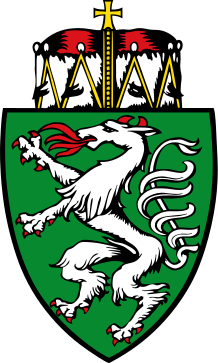Text is from Wikipedia - the free encyclopaedia,
unless otherwise stated.

Admont Abbey Library,
Austria.
Photo: 11 September 2009.
Source: Own work.
Author: © Jorge Royan / http://www.royan.com.ar
(Wikimedia Commons)
The Abbey's location, on the borders of the mountainous Gesäuse National Park (the name Admont derives from the Latin expression "ad montes," "at the mountains") is of unusual scenic beauty.
Dedicated to Saint Blaise, Admont Abbey was founded in 1074 by Archbishop Gebhard, of Salzburg, with the legacy of the Late-Saint, Hemma of Gurk, and settled by Monks from Saint Peter's Abbey, in Salzburg, Austria, under Abbot Isingrin. The second Abbot, Giselbert, is said to have introduced The Cluniac Reforms. Another of the early Abbots, Wolfhold, established a Convent for the education of girls of noble family, and the educational Tradition has remained strong ever since. The Monastery prospered during The Middle Ages and possessed a productive Scriptorium. Abbot Engelbert, of Admont, (1297–1327) was a famous scholar and author of many works.

English: Admont Abbey,
Styria, Austria.
Deutsch: Stift Admont, Foto: P. Gabriel Reiterer.
Photo: 21 September 2005.
Source: Photo: P. Gabriel Reiterer.
Author: User M. B. on de.wikipedia.
(Wikimedia Commons)
In the 17th- and 18th-Centuries, the Abbey reached a high point of artistic productivity, with the works of the world-famous Ecclesiastical Embroiderer, Brother Benno Haan (1631–1720), and the sculptor Joseph Stammel (1695–1765).
On 27 April 1865, a disastrous fire destroyed almost the entire Monastery. While the Monastic archives burned, the Library could be salvaged. Reconstruction began the following year, but was still not complete by 1890.

English: Coat-of-Arms of Styria, Austria.
Nederlands: Wapen van de deelstaat Stiermarken.
Deutsch: Landeswappen der Steiermark.
Date: Unknown date.
File: 2006-05-27.
Source: Based on Coat-of-Arms of Styria,
depicted on www.verwaltung.steiermark.at
Author: Unknown.
File: David Liuzzo.
(Wikimedia Commons)
From 1641, the Abbey was a Member of The Salzburg Congregation, which, in 1930, was merged into the present Austrian Congregation of The Benedictine Confederation.
The present Church was designed by the architect Wilhelm Bücher, to replace the former Church after the fire of 1865. It is inspired by Regensburg Cathedral and was the first Sacred Building in Austria in the Neo-Gothic Style. It incorporates 12th-Century Romanesque Side Doors. The two West Towers are sixty-seven metres tall, and the facade contains figures of Saint Benedict and Saint Scholastica. The figure of the Church's Patron, Saint Blaise, tops the Pinnacle of The Great West Door.

English: The Nave of Admont Abbey Church, Admont, Styria, Austria.
Deutsch: Langhaus der Stiftskirche Admont, Admont, Steiermark.
Photo: 18 June 2012.
Source: Own work.
Author: Zairon.
(Wikimedia Commons)
In a Side Chapel, is located the famous Crib of Admont, also by Stammel. It is open to view from 25 December to 2 February. The Gothic Crucifix, under The Triumphal Arch, dated 1518, is ascribed to Andreas Lackner.
A statue of Saint Blaise stands on top of The High Altar of White Carrara Marble. The Choir is decorated with Early-18th-Century Tapestries, by Benno Haan. In The Chapel of Saint Benedict, is a Baroque Corpus Christi, from the Workshop of Johann Meinrad Guggenbichler.

English: The Abbey Church,
Admont Abbey,
Austria.
Deutsch: Stift Admont, Stiftskirche.
Photo: 14 February 2007.
Source: Own work.
Author: User:Fb78.
(Wikimedia Commons)
The Library Hall, built in 1776 to designs by the architect Joseph Hueber, is seventy metres long, fourteen metres wide and thirteen metres high, and is the largest Monastery Library in the World. It contains circa 70,000 volumes of the Monastery's entire holdings of circa 200,000 volumes. The Ceiling consists of seven Cupolas, decorated with frescoes by Bartolomeo Altomonte showing the stages of human knowledge up to the high point of Divine Revelation. Light is provided by forty-eight windows and is reflected by the original colour scheme of Gold and White. The architecture and design express the ideals of The Enlightenment, against which the sculptures by Joseph Stammel of "The Four Last Things" make a striking contrast.
The Abbey possesses over 1,400 Manuscripts, the oldest of which, from Saint Peter's Abbey, in Salzburg, Austria, were the gift of the Founder, Archbishop Gebhard, and accompanied the first Monks to settle here, as well as over 900 Incunabulae.

English: The Nave of Admont Abbey Church, Admont, Styria, Austria.
Deutsch: Langhaus der Stiftskirche Admont, Admont, Steiermark.
Photo: 18 June 2012.
Source: Own work.
Author: Zairon.
(Wikimedia Commons)
The Abbey also houses two major Art Collections of Historical and Modern Art. The Historical Art Collection was begun in 1959 by Father Adalbert Krause, and has been significantly augmented since 1980. The present Museum was opened in 2003. The Collection particularly features Ecclesiastical Art, and contains, for example, many works of Ecclesiastical Embroidery by the famous Craftsman, Benno Haan, and of the Abbey Sculptor, Joseph Stammel.
Since 1997, the Abbey has also been building up a Collection of Contemporary Art, largely produced by young Austrian artists and often specially designed for the Abbey premises.

English: Admont Abbey Church viewed from the Park.
Deutsch: Ansicht der Stiftskirche Admont vom Park, Steiermark.
Photo: 3 May 2014.
Source: Own work.
Author: Uoaei1.
(Wikimedia Commons)

No comments:
Post a Comment